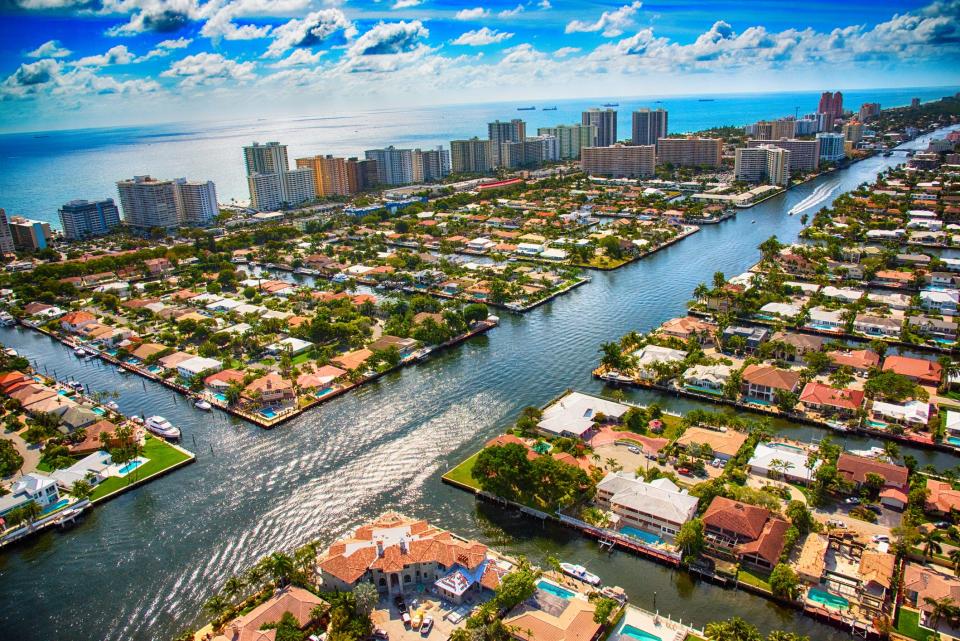Climate change threatens America's cities. We need to act now to protect them.
Miami recently declared a climate emergency. It was not a symbolic gesture. The vibrant metropolis faces an existential threat as it battles rising sea levels and increasingly violent Atlantic storms.
As a city, Miami has done everything it can to protect its residents. In 2017, residents voted to raise their own taxes to build stronger flood defenses. They raised $400 million for a Miami Forever Bond that is pioneering a new approach to climate adaptation.
There is only so much a city — even as the Greater Miami Area, with its more than 6 million residents — can do to address these multiple challenges. The rise in sea levels is accelerating. The World Resources Institute estimates it has the largest amount of property and the fourth-largest population vulnerable to sea-level rise.
Hurricane Irma in 2017 drove home this tragic vulnerability by causing $50 billion worth of damage to homes, businesses and infrastructure. And it isn’t just physical assets that are in danger. If efforts to stay above water were to fail, tourism, which supports 1.4 million jobs in Florida, also would be at risk.
Let's climate-proof American cities
That is why we urgently need a national plan with bipartisan support to climate-proof American states and cities. As a nation, the United States has neglected the backbone of its economy for too long. The United States hasn’t seen a major public works program since the Eisenhower administration. That was six decades ago.

As a result, much of U.S. infrastructure, from highways to water pipes and energy grids, is approaching the end of its useful life. In its 2017 Infrastructure Report Card, the American Society of Civil Engineers gave the U.S. a D-plus. It estimates the funding gap between infrastructure needs and expected government spending over the next decade at more than $2 trillion.
That is an extraordinary amount, but the cost of doing nothing would be even higher. By 2025, the impact of crumbling infrastructure on lost business, higher transportation costs and other economic headwinds could wipe out $4 trillion in gross domestic product and destroy 2.5 million jobs, ASCE says.
Talking it out: Learning to discuss complicated issues ahead of the election
We want to hear from you: Be a part of the solution to finding solutions. Tell us here.
Climate-related shocks could raise that bill. Hurricane Sandy caused 8.7 million customers to lose power, prompting utilities in New York and New Jersey to spend billions on water-proofing underground electricity networks.
The latest government-sponsored National Climate Assessment notes that inland flooding from increased rainfall could cause $1.2 billion to $1.4 billion in annual damage just to bridges by 2050.
Candidates on climate change:Review how the presidential contenders would address the global challenge.
So when President Donald Trump announced his $1.5 trillion infrastructure investment plan in 2018, both Democrats and Republicans gave it a warm welcome. But the plan has slipped from the president’s agenda, and Democrats are too preoccupied with impeachment to focus on the real threat to the nation. Meanwhile, California has burned, Iowa has suffered record flooding, and cities like Miami have been left to fend for themselves.
Trump's plan is insufficient
Ambitious as it was, the president’s infrastructure plan had a blind spot: It made no mention of climate change. In our view, this could be a costly mistake. Not to consider climate change when planning infrastructure means we could end up building the wrong things, in the wrong place, to the wrong standards. That would be a big waste of taxpayer dollars.
There is an opportunity here. Instead of trying to repair the infrastructure of the past, America could be building the resilient roads, bridges, flood-prevention systems and electricity grids we need for the future.
The good news is that investing in building resilience makes good economic sense. The Global Commission on Adaptation estimates that every dollar spent on climate-proofing communities can deliver a fourfold return on investment.
We are not underestimating the scale of the challenge: This is a huge endeavor. A national resilience plan must guide how and where we invest, how businesses function, and how cities are designed and built. Everyone — from mayors to taxpayers, insurers to engineers, property developers to urban planners — will need to be engaged. The plan will require unprecedented coordination among all stakeholders, especially federal, state and local governments. It can be done, but the president must lead the way with Congress behind him.
Climate change does not discriminate between red and blue states; it affects us all. That is why Florida Republicans are addressing climate in their programs, and why we urge President Trump to do the same.
Millions of American lives are being disrupted by climate change. There is another way. America has a once-in-a-lifetime opportunity to build smartly to adapt to the foreseeable impacts of climate change. These investments will save lives and deliver economic returns. If President Trump were to embrace a national resilience plan, it could become his lasting and most important legacy.
Ban Ki-moon, chair of the Global Commission on Adaptation and Global Center on Adaptation, was the eighth secretary-general of the United Nations. Before becoming secretary-general, he was foreign minister of the Republic of South Korea. Patrick Verkooijen, CEO of the Global Center on Adaptation, is professor of practice of sustainable development diplomacy at The Fletcher School at Tufts University.
You can read diverse opinions from our Board of Contributors and other writers on the Opinion front page, on Twitter @usatodayopinion and in our daily Opinion newsletter. To respond to a column, submit a comment to letters@usatoday.com.
This article originally appeared on USA TODAY: Infrastructure investment needed to climate-proof U.S. cities, states

